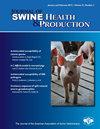产房加热灯和加热垫的比较:通过现场观察对仔猪生产、能量使用以及仔猪和母猪行为的影响
IF 0.7
4区 农林科学
Q3 Agricultural and Biological Sciences
引用次数: 4
摘要
目的:确定热灯与热垫对仔猪生产性能指标、母猪产蛋行为、仔猪行为和能源使用的影响。材料与方法:选取17头分娩期杂交母猪,随机分为两种热源处理:仔猪热垫-单48 (Mat);n = 8)或聚热灯具(Lamp;n = 9)。仔猪在第1天和断奶时称重,记录任何死亡情况,以评估仔猪生产措施。在泌乳期的第7天(第1、2、3、4、5天,断奶前1周,断奶前1天),对母猪及其窝仔进行2小时的观察,每天2次,以评价其行为。每个热源单元都安装了电表,以监测能源使用情况。结果:仔猪生产参数不受处理类型的影响;仔猪断奶重(P = 0.85)、仔猪平均日增重(P = 0.79)和断奶前死亡率(P = 0.58)。仔猪行为在不同处理期间使用热源的仔猪数量存在差异(P < 0.001)。两种处理类型与母猪接触的仔猪数量在泌乳早期均有所减少,在泌乳后期均有所增加,且更多的MAT猪倾向于与母猪接触(P < 0.001)。意义:在产房中使用热垫作为补充热量可以减少能源使用,增加节约,而不会影响仔猪生产参数。本文章由计算机程序翻译,如有差异,请以英文原文为准。
Comparison of heat lamps and heat mats in the farrowing house: effect on piglet production, energy use, and piglet and sow behavior through live observation
Objectives: To determine the effect of heat lamps versus heat mats on piglet performance measures, sow lying behavior, piglet behavior, and energy use. Materials and methods: Seventeen multiparous crossbred sows housed in farrowing stalls were randomly assigned to one of two heat source treatments: Baby Pig Heat Mat - Single 48 (MAT; n = 8) or Poly Heat Lamp Fixture (LAMP; n = 9). Piglets were weighed on day 1 and at weaning and any mortalities were recorded to evaluate piglet production measures. For 7 days over the course of lactation (day 1, 2, 3, 4, 5, week before weaning, and day before weaning), sows and their litters were observed for 2 hours twice daily to evaluate behavior. Electric meters were attached to individual heat source units to monitor energy use. Results: Piglet production parameters were unaffected by treatment type; litter weaning weight (P = .85), litter average daily gain (P = .79), and preweaning mortality (P = .58). Piglet behavior had variation in the number of piglets using a heat source within day across treatments (P < .001). The number of piglets in contact with the sow decreased during early lactation for both treatment types and increased during late lactation with more MAT pigs tending to be in contact with the sow (P < .001). Implications: Using heat mats as supplemental heat in the farrowing house may result in decreased energy use and increased savings without hindering piglet production parameters.
求助全文
通过发布文献求助,成功后即可免费获取论文全文。
去求助
来源期刊
CiteScore
1.80
自引率
0.00%
发文量
29
审稿时长
>36 weeks
期刊介绍:
The Journal of Swine Health & Production (JSHAP) is an open-access and peer-reviewed journal published by the American Association of Swine Veterinarians (AASV) since 1993. The aim of the journal is the timely publication of peer-reviewed papers with a scope that encompasses the many domains of applied swine health and production, including the diagnosis, treatment, management, prevention and eradication of swine diseases, welfare & behavior, nutrition, public health, epidemiology, food safety, biosecurity, pharmaceuticals, antimicrobial use and resistance, reproduction, growth, systems flow, economics, and facility design. The journal provides a platform for researchers, veterinary practitioners, academics, and students to share their work with an international audience. The journal publishes information that contains an applied and practical focus and presents scientific information that is accessible to the busy veterinary practitioner as well as to the research and academic community. Hence, manuscripts with an applied focus are considered for publication, and the journal publishes original research, brief communications, case reports/series, literature reviews, commentaries, diagnostic notes, production tools, and practice tips. All manuscripts submitted to the Journal of Swine Health & Production are peer-reviewed.

 求助内容:
求助内容: 应助结果提醒方式:
应助结果提醒方式:


